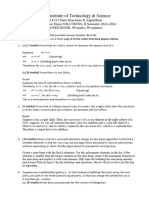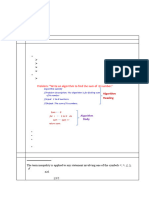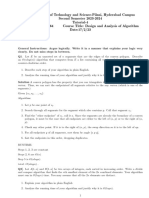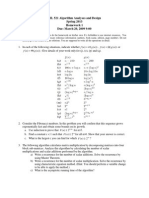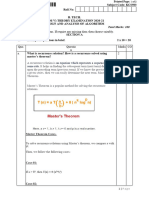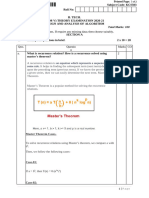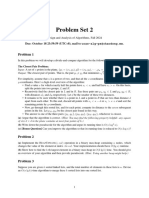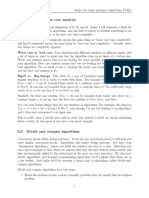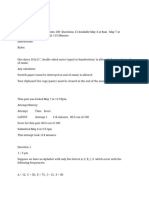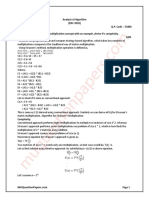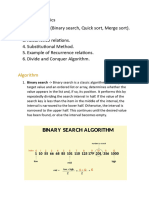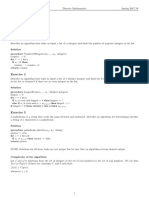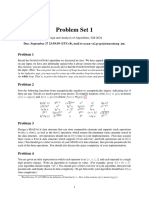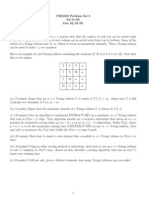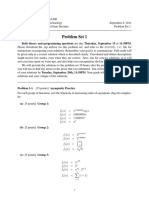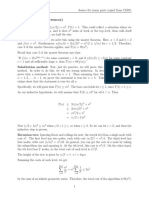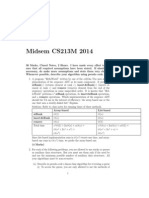S Midsol
S Midsol
Uploaded by
Sachin MichuCopyright:
Available Formats
S Midsol
S Midsol
Uploaded by
Sachin MichuOriginal Title
Copyright
Available Formats
Share this document
Did you find this document useful?
Is this content inappropriate?
Copyright:
Available Formats
S Midsol
S Midsol
Uploaded by
Sachin MichuCopyright:
Available Formats
CS 4120 Analysis of Algorithms A term 2010
Solutions for the Practice Midterm Exam
These problems are sample problems for the midterm exam, so you may expect similar problems in the midterm. Do not hand in your solutions. Solutions will be handed out, discussed (and posted on the web) on Monday, the day before the exam. The midterm exam is a closed book exam, but you may use one sheet of paper (written on both sides) with notes on it. Each problem is worth 20 points. 1. Use the Master Theorem to nd the asymptotic solutions for the following recurrences: (a) T (n) = 7T ( n ) + n2 , 2 (b) T (n) = T ( n ) + 1, 2 (c) T (n) = 4T ( n ) + n3 . 2 Solution: (a) We have a = 7, b = 2, f (n)/nlog2 7 = n2 /nlog2 7 = n2log2 7 = O(n0.8 ), we get Case 1, and thus T (n) = (nlog2 7 ). (b) We have a = 1, b = 2, f (n) = (1) = (nlog2 1 ) = (1), we get Case 2, and thus T (n) = (log2 n). (c) We have a = 4, b = 2, f (n)/nlog2 4 = n3 /n2 = n, we get Case 3, and thus T (n) = (n3 ). Note that the regularity condition is satised as 4(n/2)3 = n3 /2 cn3 for c = 1/2. 1
2. Use indicator random variables to nd the expected value of the number of xed elements (elements left in the same position) in a random permutation of n elements. Solution: Let Xi = 1 if the ith element is a xed element 0 otherwise
Then by the linearity of expectation
n n
E(X) = E(
i=1
Xi ) =
i=1
E(Xi ) =
1 = 1. i=1 n
3. We have two input arrays, an array A with m elements and an array B with n elements, where m n. There may be duplicate elements. We want to decide if every element of B is an element of A. Describe an algorithm to solve this problem in O(n log m) worst-case time. Solution: First we sort A by MERGESORT (in O(m log m) time). Then for each element of B we do a binary search in the sorted list of A (in O(n log m) time). The total worst-case running time is O((m + n) log m) = O(n log m). 4. Assume that you want to sort an array of n numbers, each of which is a member of the set {0, 1, 2, 3, 4}. A sample input for n = 6 is (3, 1, 0, 3, 4, 3). Describe an optimal algorithm to solve this problem and prove that it is optimal; that is give a lower bound on the worst-case running time that has the same order of magnitude as the worst-case running time of your algorithm. Solution: This is just COUNTING-SORT with k = 4 with O(n) running time. We can give a linear time lower bound for solving the problem by observing that if an algorithm does not examine some element (examining all elements takes linear time), then this element may be changed by the adversary and the algorithm will give the same answer, which is now incorrect. 5. We have an input array A with n (n 2) numbers.
(a) Describe a O(n) worst-case time algorithm to nd two elements x, y A such that |x y| |u v| for all u, v A. (b) Describe a O(n log n) worst-case time algorithm to nd two elements x, y A such that |x y| |u v| for all u, v A. Solution: (a) For this we have to nd the minimum and the maximum simultaneously which we can do in 3 n/2 = O(n) time. (b) For this we sort the numbers rst, then x and y must be consecutive elements in the sorted order. We go through the sorted list and we nd the smallest dierence between two neighboring elements.
You might also like
- PMI Report TemplateDocument2 pagesPMI Report TemplateKewell LimNo ratings yet
- Chapter 11 ProblemsDocument3 pagesChapter 11 ProblemsIna LinnyNo ratings yet
- 9841 - Manual On The Approval of Flight Crew Training Organizations - Preliminary - EdDocument26 pages9841 - Manual On The Approval of Flight Crew Training Organizations - Preliminary - EdSms DmgNo ratings yet
- Chassis Vehicle Dynamics TechnologyDocument32 pagesChassis Vehicle Dynamics TechnologyAnonymous WDTFw8EK0% (1)
- Test 1 Review and Practice QuestionsDocument7 pagesTest 1 Review and Practice QuestionselsainetedelautrecNo ratings yet
- CSCI 3110 Assignment 6 Solutions: December 5, 2012Document5 pagesCSCI 3110 Assignment 6 Solutions: December 5, 2012AdamNo ratings yet
- Exam SolDocument4 pagesExam SolgsandynitwNo ratings yet
- Practice ProblemsDocument4 pagesPractice ProblemsGanesh PeketiNo ratings yet
- CSF211 2024 MidsemSolutionsDocument6 pagesCSF211 2024 MidsemSolutionsDIY HJ HACKSNo ratings yet
- Practice Sheet Divide and ConquerDocument5 pagesPractice Sheet Divide and ConquerApoorva GuptaNo ratings yet
- Ps 1 SolDocument3 pagesPs 1 SolPang XsNo ratings yet
- ADA 35 Questions Solution (1)Document56 pagesADA 35 Questions Solution (1)telebe3450No ratings yet
- IGNOU BCA AssignmentDocument39 pagesIGNOU BCA AssignmentdollarsageNo ratings yet
- 002 DcproblemsDocument8 pages002 DcproblemsTayyab UsmanNo ratings yet
- Tut 4 SolutionsDocument2 pagesTut 4 Solutionsarunachala.gamingNo ratings yet
- Homework 1Document3 pagesHomework 1Salih_Bak_r_8581No ratings yet
- Algorithms Solution - 2Document9 pagesAlgorithms Solution - 2MiltonNo ratings yet
- Design and Analysis of Algorithms - Tutorial Sheet PracticeDocument2 pagesDesign and Analysis of Algorithms - Tutorial Sheet PracticeMIHIKA PARAG DESHPANDENo ratings yet
- Notes On Divide-and-Conquer and Dynamic Programming.: 1 N 1 n/2 n/2 +1 NDocument11 pagesNotes On Divide-and-Conquer and Dynamic Programming.: 1 N 1 n/2 n/2 +1 NMrunal RuikarNo ratings yet
- Lab 2Document7 pagesLab 2RanaAshNo ratings yet
- National Institute of Technology RourkelaDocument2 pagesNational Institute of Technology RourkelaThanoj KumarNo ratings yet
- Exercise 3Document4 pagesExercise 3Khalil El LejriNo ratings yet
- Partial Solutions Manual Parallel and Distributed Computation: Numerical MethodsDocument95 pagesPartial Solutions Manual Parallel and Distributed Computation: Numerical Methodsblack272727No ratings yet
- DAA-20-21Document28 pagesDAA-20-21rajesh.kumarcisceNo ratings yet
- DSA Assignment 1-SolutionsDocument10 pagesDSA Assignment 1-SolutionsChatianya ChaniyaraNo ratings yet
- Cs 161 Lecture 04Document6 pagesCs 161 Lecture 04divyatamboli08No ratings yet
- DAA-20-21Document27 pagesDAA-20-21utkarsh7553No ratings yet
- Ps1 Solution (VERY IMP)Document6 pagesPs1 Solution (VERY IMP)Omega ManNo ratings yet
- COMP 3250 B - Design and Analysis of Algorithms (Advanced Class)Document2 pagesCOMP 3250 B - Design and Analysis of Algorithms (Advanced Class)Z GooNo ratings yet
- 10910 計算方法設計 許健平 mid1Document6 pages10910 計算方法設計 許健平 mid1940984326No ratings yet
- 7-5 Solution PDFDocument3 pages7-5 Solution PDFDaniel Bastos MoraesNo ratings yet
- ps2Document3 pagesps2sunshiyao0No ratings yet
- Problem Set 5Document4 pagesProblem Set 5Yash VarunNo ratings yet
- CMSC 251: Algorithms: Spring 1998Document30 pagesCMSC 251: Algorithms: Spring 1998Anthony-Dimitri ANo ratings yet
- Solutions To Homework 4: 1 Problem 2.23Document6 pagesSolutions To Homework 4: 1 Problem 2.23bharadwajrohanNo ratings yet
- 0.1 Worst and Best Case AnalysisDocument6 pages0.1 Worst and Best Case Analysisshashank dwivediNo ratings yet
- MidtermDocument19 pagesMidtermjumpman006No ratings yet
- Homework # 1: Design and Analysis of Algorithms CS 302 Spring 2019Document4 pagesHomework # 1: Design and Analysis of Algorithms CS 302 Spring 2019Amna ArshadNo ratings yet
- SE-Comps SEM4 AOA-CBCGS DEC18 SOLUTIONDocument15 pagesSE-Comps SEM4 AOA-CBCGS DEC18 SOLUTIONSagar SaklaniNo ratings yet
- DAA Practical FileDocument41 pagesDAA Practical Filepavitra.bijytNo ratings yet
- Lab ManualDocument20 pagesLab ManualMuthukrishnan NNo ratings yet
- Introduction To Algorithms: Problem Set 1 SolutionsDocument5 pagesIntroduction To Algorithms: Problem Set 1 Solutionssasan_codeNo ratings yet
- CS510 ProblemSet 3 Divide N ConquerDocument5 pagesCS510 ProblemSet 3 Divide N ConquerAyush PatelNo ratings yet
- Module 2Document7 pagesModule 2farispalayiNo ratings yet
- Tutorial1 SolutionsDocument4 pagesTutorial1 Solutionsjohn doeNo ratings yet
- Minimum and MaximumDocument28 pagesMinimum and MaximumDinoNo ratings yet
- Ada 1Document11 pagesAda 1kavithaangappanNo ratings yet
- 3-Divide and Conquer ApproachDocument140 pages3-Divide and Conquer ApproachRaju YadavNo ratings yet
- CMSC-5343 Algorithm Analysis Homework 1Document1 pageCMSC-5343 Algorithm Analysis Homework 1Robin AwalNo ratings yet
- Assignment 1 AoADocument14 pagesAssignment 1 AoAyounuskhansherani045No ratings yet
- Algorithms AnalysisDocument25 pagesAlgorithms Analysislyhoangkhang831No ratings yet
- Exercise Sheet 13Document4 pagesExercise Sheet 13AKum អាគមNo ratings yet
- The Institute of Mathematical Sciences C. I. T. Campus Chennai - 600 113. Email: Vraman@imsc - Res.inDocument25 pagesThe Institute of Mathematical Sciences C. I. T. Campus Chennai - 600 113. Email: Vraman@imsc - Res.inrocksisNo ratings yet
- The Fundamentals: Algorithms The IntegersDocument55 pagesThe Fundamentals: Algorithms The Integersnguyên trần minhNo ratings yet
- ps1Document2 pagesps1sunshiyao0No ratings yet
- Problem SetDocument2 pagesProblem SetGobara DhanNo ratings yet
- MIT6 006F11 ps1 PDFDocument6 pagesMIT6 006F11 ps1 PDFlinchiNo ratings yet
- 2017 Mid-Daa SolutionDocument16 pages2017 Mid-Daa SolutionDebanik DebnathNo ratings yet
- 0.1 Review (Recurrences)Document8 pages0.1 Review (Recurrences)shashank dwivediNo ratings yet
- MidsemDocument6 pagesMidsemAravind SomasundaramNo ratings yet
- A-level Maths Revision: Cheeky Revision ShortcutsFrom EverandA-level Maths Revision: Cheeky Revision ShortcutsRating: 3.5 out of 5 stars3.5/5 (8)
- Practical Finite Element Modeling in Earth Science using MatlabFrom EverandPractical Finite Element Modeling in Earth Science using MatlabNo ratings yet
- 10+2 Level Mathematics For All Exams GMAT, GRE, CAT, SAT, ACT, IIT JEE, WBJEE, ISI, CMI, RMO, INMO, KVPY Etc.From Everand10+2 Level Mathematics For All Exams GMAT, GRE, CAT, SAT, ACT, IIT JEE, WBJEE, ISI, CMI, RMO, INMO, KVPY Etc.No ratings yet
- Slash Harmonic Pattern Trading StrategyDocument9 pagesSlash Harmonic Pattern Trading StrategyBabbli SinghNo ratings yet
- Values MotivationDocument31 pagesValues MotivationfaidhnasrNo ratings yet
- A Natural HistoryDocument320 pagesA Natural HistorySotiris Ktistis50% (2)
- Spearman Rank Order Correlation CoefficientDocument18 pagesSpearman Rank Order Correlation CoefficientFia JungNo ratings yet
- Access Assignment QuestionDocument6 pagesAccess Assignment QuestionAshish MeenaNo ratings yet
- Holiday Homework XTHDocument2 pagesHoliday Homework XTHrobertoNo ratings yet
- Scrum Process Chart 1.1Document2 pagesScrum Process Chart 1.1Zameer AhmadNo ratings yet
- Aci 347-04Document9 pagesAci 347-04John Rhey Almojallas BenedictoNo ratings yet
- Reconsideration of The World Design Conference 1960 in Tokyo and Theworld Industrial Design Conference 1973 in KyotoDocument10 pagesReconsideration of The World Design Conference 1960 in Tokyo and Theworld Industrial Design Conference 1973 in KyotokenkothecatNo ratings yet
- BESMM4 1-41 Sections PricedDocument132 pagesBESMM4 1-41 Sections PricedJimoh SodiqNo ratings yet
- Fluid 1 LabDocument18 pagesFluid 1 LabHassan MehrizNo ratings yet
- Tugas Menerjemahkan Bahasa Inggris Oleh Hanifah AntoniDocument2 pagesTugas Menerjemahkan Bahasa Inggris Oleh Hanifah AntoniHani AntonnyNo ratings yet
- Pds Nexiuszoomevo enDocument6 pagesPds Nexiuszoomevo enMarketing Ecosains HayatiNo ratings yet
- GFEDocument56 pagesGFENishikant SharmaNo ratings yet
- XP Command LineDocument4 pagesXP Command Lineraghv100% (1)
- RPH M27 - HAIWAN LIAR Selasa 2023Document3 pagesRPH M27 - HAIWAN LIAR Selasa 2023Nor Zulaikha Binti LaungahNo ratings yet
- Nest - 13 - Set A: The FINAL Answers For The Question PapersDocument2 pagesNest - 13 - Set A: The FINAL Answers For The Question PapersRishi Dey ChowdhuryNo ratings yet
- Matrix Multiplication Algorithms With Better Time ComplexityDocument9 pagesMatrix Multiplication Algorithms With Better Time ComplexityTrọng Chuẩn NguyễnNo ratings yet
- ENGLISH 9 Q1 W2 Use Conditionals in Expressing ArgumentsDocument5 pagesENGLISH 9 Q1 W2 Use Conditionals in Expressing Argumentsglenn salvador iv limNo ratings yet
- Teaching Music To Autistic ChildrenDocument4 pagesTeaching Music To Autistic ChildrenBárbara de SouzaNo ratings yet
- Birla Institute of Technology, Mesra, Ranchi-835215 (India) : Signature Not VerifiedDocument5 pagesBirla Institute of Technology, Mesra, Ranchi-835215 (India) : Signature Not VerifiedHarshit JainNo ratings yet
- AI 71324 Beer Analysis Application Notebook AI71324 enDocument30 pagesAI 71324 Beer Analysis Application Notebook AI71324 enmikicacicaNo ratings yet
- System_of_equationsDocument66 pagesSystem_of_equationsmintahgodwin23No ratings yet
- Freddy Jackson Brown and Duncan Gillard - The 'Strange Death' of Radical BehaviourismDocument4 pagesFreddy Jackson Brown and Duncan Gillard - The 'Strange Death' of Radical BehaviourismIrving Pérez MéndezNo ratings yet
- hsk3 Exam h31330Document18 pageshsk3 Exam h31330Eva DongNo ratings yet
- Sterilizing Grade Filter & Filter Validation - Mr. Ajeet Singh - 09-03-2007Document29 pagesSterilizing Grade Filter & Filter Validation - Mr. Ajeet Singh - 09-03-2007ajeets362791% (11)









